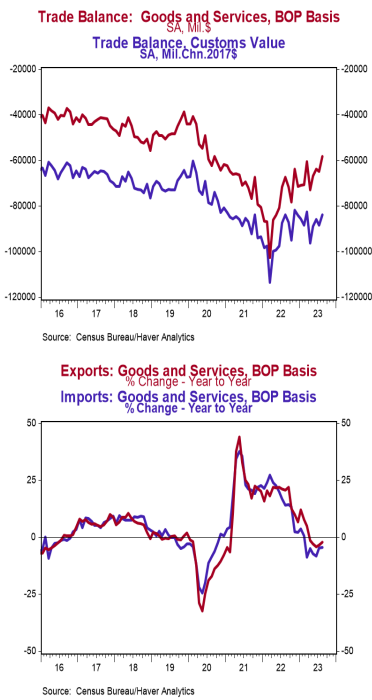- The trade deficit in goods and services came in at $58.3 billion in August, smaller than the consensus expected $59.8 billion.
- Exports rose by $4.1 billion, led by crude oil and fuel oil. Imports declined by $2.3 billion, led by cell phone & other household goods, autos, and semiconductors.
- In the last year, exports are down 2.1% while imports are down 4.4%.
- Compared to a year ago, the monthly trade deficit is $9.0 billion smaller; after adjusting for inflation, the “real” trade deficit in goods is unchanged from a year ago. The “real” change is the trade indicator most important for measuring real GDP.
Implications:
The trade deficit in goods and services shrunk to $58.3 billion in August, the smallest since 2020, as exports expanded while imports declined. Plugging this into our models suggests net exports will add substantially to measured growth in Real GDP in the third quarter. However, we prefer to focus on the total volume of trade, imports plus exports, as it shows the extent of business and consumer interaction across the US border. This measure expanded by $1.9 billion in August but remains down 3.4% versus a year ago. Although the growth in August is positive, both imports and exports are down on a year-ago basis, consistent with our forecast that the US is headed toward a recession. And while a recent surge in the federal budget deficit might have helped the US economy avoid recession in the short-term, this kind of artificial support can’t last. Imports are sitting near the lowest level since 2021, indicating weakening demand for goods domestically, as there is a continuing trend toward spending on services. So far this year, imports from China are down 25.1% versus the same timeframe a year ago, dropping China from first to the third largest exporter to the US, behind Mexico and Canada. Daily freight rates have fallen rapidly and are back down to pre-COVID levels, or lower, as demand for shipping has also weakened. This was confirmed by the New York Fed’s Global Supply Chain Pressure Index in August, with the index staying in negative territory, 1.08 standard deviations below the index’s historical average. Weaker demand coupled with an easing of parts shortages and less shipping congestion have pulled the indicator lower. The most positive piece of today’s report was the dollar value of US petroleum exports exceeding imports once again. This marks the 18th consecutive month of the US being a net exporter of petroleum products. In employment news this morning, initial claims for jobless benefits rose 2,000 last week to 207,000. Continuing claims fell 1,000 to 1.664 million. We expect Friday’s payroll report to show a nonfarm payroll gain of 160,000.





